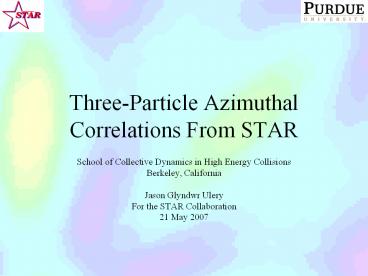Three-Particle Azimuthal Correlations From STAR
1 / 18
Title:
Three-Particle Azimuthal Correlations From STAR
Description:
Three-Particle Azimuthal Correlations From STAR School of Collective Dynamics in High Energy Collisions Berkeley, California Jason Glyndwr Ulery –
Number of Views:89
Avg rating:3.0/5.0
Title: Three-Particle Azimuthal Correlations From STAR
1
Three-Particle Azimuthal Correlations From STAR
- School of Collective Dynamics in High Energy
Collisions - Berkeley, California
- Jason Glyndwr Ulery
- For the STAR Collaboration
- 21 May 2007
2
Motivation
4.0ltPTTriglt6.0 GeV/c 0.15ltPTAssoclt4.0 GeV/c
- Jets are expected to be modified by the medium we
create and therefore can be used to probe the
medium. - 2-Particle correlations show broadened or double
humped away-side. - Mach-cone
- Cerenkov gluon radiation
- Jets deflected by radial flow or path length
dependent energy loss. - Large angle gluon radiation
- 3-particle correlations can distinguish conical
emission from other mechanisms.
3
Analysis Procedure
Trigger
- Trigger particle selected with transverse
momentum 3ltpTlt4 GeV/c. - Look at ???Assoc-?Trigger for all pairs of
associated particles with 1ltpTlt2 GeV/c. - Plot ??1 vs ??2 for each pair of associated
particles. - Particles are assumed to be jet-like or
background. - Raw signal contains (JetBkgd) x (JetBkgd).
- To obtain Jet x Jet we must subtract Bkgd x Bkgd
and Jet x Bkgd (and Bkgd x Jet.)
??1
??2
??2 (radians)
??1 (radians)
4
Jet x Background (Hard-Soft)
- Top plot is 2-particle correlation.
- Red is Jet Background
- Black is Background (from mixed events with v2
and v4 added) and blue is scaled background (such
that Red - blue is zero around 1.) - Mini panel is background subtracted signal.
- Jet x Background term is created by folding
2-particle jet-like signal (mini panel) with
2-particle background.
??
??2
??1
5
Background x Background (Soft-Soft)
- Term is constructed by mixing a trigger particle
from one event with pairs of background particles
from another event of the same centrality. - Contains correlations between associated
particles that are not associated with a trigger
particle (including the flow between the 2
associated particles).
??2
??1
6
Flow
- Soft-soft term contains from between the
associated particles irrespective of the trigger. - Other flow terms must still be subtracted.
- Top plot contains terms of v2Triggerv2Associated.
- Bottom plot contains terms of v4Triggerv4Associat
ed and v2v2v4 with v4 1.15v22. - v2 is taken as average of reaction plane and
4-particle measurements.
7
Background Subtraction
Raw Signal
8
Conical Flow vs Deflected Jets
9
Centrality Dependence
pp
dAu
AuAu 50-80
AuAu 30-50
AuAu 10-30
AuAu 0-10
10
Projections
AuAu 0-12
AuAu 10-30
dAu
(??1??2)/2
(??1-??2)/2
11
Centrality Dependence of the Signal
Away
Cone
Cone Deflected
Average Signal in 0.7x0.7 Squares
- Cone and cone deflected at 1.45 radians from ?.
- Positive conical emission signal seen in central
AuAu collisions.
12
Associated PT Dependence
- Mach cone signals should display no pT dependence
of the angle. - Current Cerenkov gluon radiation models predict
decreasing angle with pT.
13
Angle from Fits
- Fit of off-diagonal projections to Gaussians to
extract conical emission angle. - Shaded errors are systematic and solid are
statistical. - Fitting angle from different centralities to a
constant gives an angle of 1.47. - Angle consistent with flat or increasing with
associated pT. - Inconsistent with current Cerenkov radiation
models. - Fitting points to a constant gives angles for
1.41 for ZDC triggered 0-12 AuAu and 1.46 for
0-50 AuAu from minimum bias.
14
Systematics
- Major sources of systematic error are from the
elliptic flow measurement and the normalization.
- Off-diagonal signal robust with respect to
variations in v2 and normalization. - Other sources include
- effect on the trigger particle flow from
requiring a correlated particle (20 on trigger
particle v2) - uncertainty in the v4 parameterization
- multiplicity bias effects on the soft-soft
background
Reaction Plane v2
4-Particle v2
Wide Normalization
15
Conclusions
- Within the jet-like background model, we
conclude - On-diagonal elongation is seen in pp, dAu
consistent with kT broadening. - Additional elongation in AuAu is consistent
with additional contribution from deflected jets.
- Evidence for conical flow.
- Consistent with Mach cone, inconsistent with
simple Cerenkov radiation.
16
(No Transcript)
17
Extreme Systematics
No Jet Flow
No v2Triggerv2Associated
- No jet flow systematic has the jet not flowing
with the medium. - No v2Triggerv2Associated has no subtraction of
the v2 terms. - Signal persists even in these extreme cases.
(??1-??2)/2
18
Hard-Soft Plus Flow
- Flow contributions from v2Triggerv2Associated
and v4Triggerv4Associated cancel to first order. - Robust with respect to variations in flow.
??2
??1































